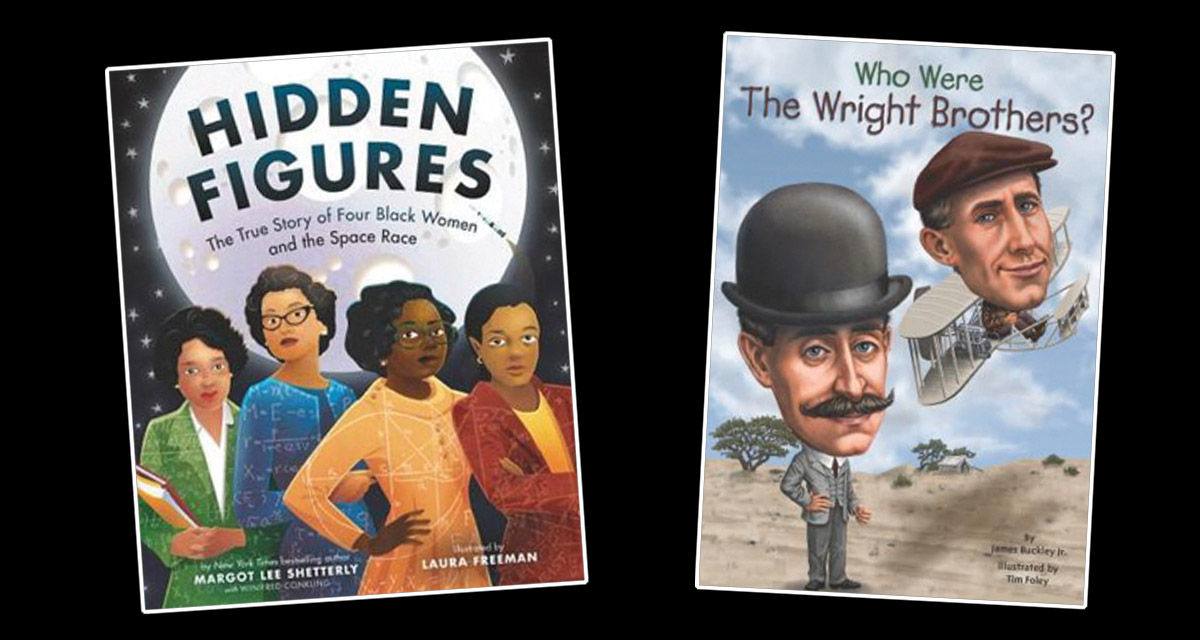Each month I spotlight two books guaranteed to delight readers and provide fun activities to further extend the meaning of each reading experience. With so many wonderful titles available, this is no easy task! I bring a 35-year teaching career, literacy expertise, and a passion for creating joyful readers and writers to every column I write. I certainly hope you enjoy this month’s picks as much as I do.
A (FIRST) PLACE IN HISTORY…THE SKY’S THE LIMIT
While in Washington, D.C. over Memorial Day weekend, I toured The National Air and Space Museum of the Smithsonian Institute. One exhibit after another showcased the ingenuity, creativity, and determination of individuals responsible for the many, many incredible “firsts” that have propelled mankind forward through the centuries. For example, De Rozier and d’Arlandes of France constructed the first untethered hot air balloon in 1783 that kept three passengers (a sheep, a duck, and a rooster) aloft for 15 minutes. This marvelous invention paved the way for Steve Fossett to fly around the world, nonstop, in a 10-story high, hot air- and helium-powered balloon, Spirit of Freedom, in 2002. The monoplanes designed in the late 1800s by German glider builder Otto Lilienthal demonstrated that flight was possible and proved to be the inspiration needed for Wilbur and Orville Wright to make the world’s first successful “heavier-than-air powered flight” at Kitty Hawk, North Carolina. The transition from wood, cloth, and tension wire construction of the 1903 Wright Flyer to an all-metal (aluminum, steel, and titanium) airplane was realized just a decade later when the German Junkers I made its inaugural flight. The launch of Sputnik, the world’s first artificial satellite, in 1957, began the notorious “space race” between the former Soviet Union and the United States. When Alan Shepard became the first American to travel into space in 1961, the U.S. was declared the “winner.” Days after this historic feat, President Kennedy promised that an American would land on the moon and return safely home before the end of the decade. Just eight years later, this promise was realized when the Apollo 11 crew stepped foot onto the lunar surface for the first time in human history, and Neil Armstrong announced, “The Eagle has landed. That’s one small step for man, one giant leap for mankind.” These were just some of the amazing inventions on exhibit at the museum, but at every turn, I was reminded that, indeed, anything is possible. We are only limited (on land, sea, air and space) by our imagination and fortitude!
It’s all about determination, I think, as much as anything. There are a lot of people with talent, but it’s that determination. ~Judy Blume
HIDDEN FIGURES: THE TRUE STORY OF FOUR BLACK WOMEN AND THE SPACE RACE
Based on the best-selling novel and Academy-Award nominee movie, Shetterly shares the true account of Dorothy Vaughn, Mary Jackson, Katherine Johnson, and Christine Darden, known as the “human computers” (they were brilliant mathematicians), with younger readers. These four hardworking, intelligent, and persistent African-American women rose above gender and racial barriers to carve out a place of notoriety at the National Aeronautics and Space Administration (NASA) during the “space race.” Katherine calculated the flight paths for Freedom 7, Apollo 11 and the Space Shuttle missions, and received the Presidential Medal of Freedom in 2015 for her remarkable STEM achievements. The once-hidden mathematical contributions of these four women, who helped launch some of the greatest United States successes in space, are brought to light in this hybrid text (part biography, part information). Freeman’s beautiful illustrations and helpful back matter (e.g., term glossary and timeline) make this an enjoyable and informative reading experience.
WHO WERE THE WRIGHT BROTHERS?
James Buckley Jr. shares the story behind the invention that forever changed the world in this title from the wildly popular Who Was/Were?series. Readers learn about the lives of Orville and Wilbur Wright from the time they were curious young boys to the point in time they designed, built, and flew the world’s first successful airplane. Accompanied by plentiful pen and ink sketches by Tim Foley, the text reveals little-known facts about the brothers of the famous 1903 flight at Kitty Hawk, North Carolina. For example, a serious facial injury sustained while playing ice hockey resulted in eighteen-year-old Wilbur leaving school to recover and never completing high school. However, his health problems did not keep him from reading and learning on his own in his father’s extensive library and the rest is, well…one for the history books. The common threads weaving the story together are the support of their parents, the brothers’ insatiable thirst for all things mechanical, and the winning combination for realizing a dream: strong work ethic, courage, and determination.
If you set goals and go after them with all the determination you can muster, your gifts will take you places that will amaze you! ~ Les Brown
EXTENSION ACTIVITIES
DIY Paper Airplanes
Chances are, you have made and flown a paper airplane before. However, if you have never experienced the thrill of watching a hand-crafted masterpiece soar across the cosmos of the backyard, you should give it a try. It is an inexpensive and fun activity for the whole family! The basicDart(below) is one of the easiest to fold and is guaranteed to fly well. When you are ready to take it up a notch, check out printable directions for over 40 different styles on Foldnfly.
The Basic Dart
- Fold the paper in half vertically.
- Unfold the paper and fold each of the top corners into the center line.
- Fold the top edges into the center line.
- Fold the plane in half toward you.
- Fold the wings down, matching the top edges up with the bottom edge of the body.
North Carolina’s National Parks
The U.S. National Park Service is over 100 years old and North Carolina boasts 14 locations—one of which is the Wright Brothers National Memorial at Kill Devil Hills. Orville and Wilbur Wright chose Kitty Hawk (a few miles north of Kill Devil Hills) because it had favorable conditions for testing their glider (strong, steady winds and soft, sandy landing spaces with the dunes), and because of the success of the Wright Flyer, North Carolina lays claim to the title “First in Flight.” Select one of the remaining sites and find out what makes them special. Perhaps your family has even traveled to one of these parks.
- Appalachian Trail
- Blue Ridge Parkway
- Blue Ridge National Heritage Area
- Cape Hatteras
- Cape Lookout
- Carl Sandburg Home
- Fort Raleigh
- Great Smoky Mountains
- Guilford Courthouse
- Gullah Geechee Heritage Corridor
- Moores Creek Battlefield
- Overmountain Victory Trail
- Trail of Tears























